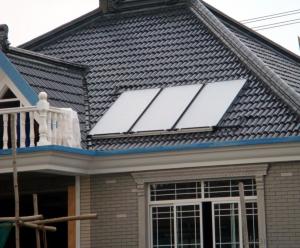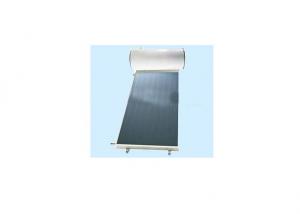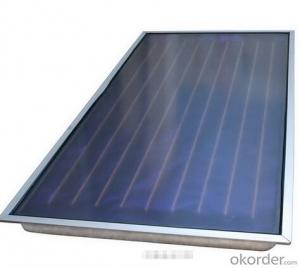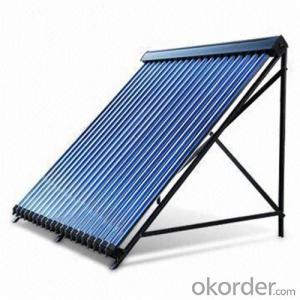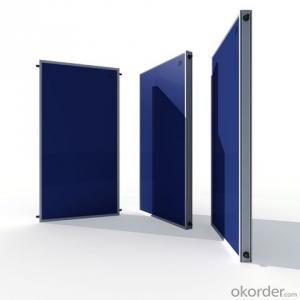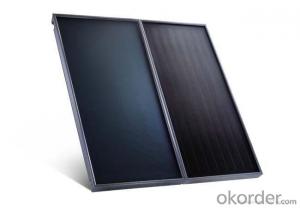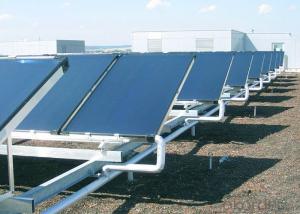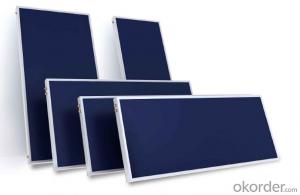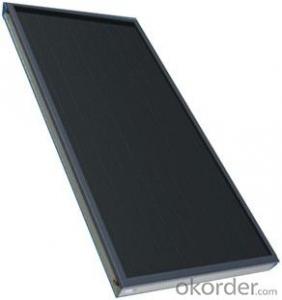Sunshore balcony type flat plate solar thermal collectors
- Loading Port:
- Shanghai
- Payment Terms:
- TT OR LC
- Min Order Qty:
- 500 pc
- Supply Capability:
- 10000 pc/month
OKorder Service Pledge
OKorder Financial Service
You Might Also Like
flat plate solar thermal collectors :
1) Cover a window on heat pipe solar collector, has better appearance.
2) Reliable and efficient twin-glass solar tubes
3) Copper heat pipes for rapid heat transfer
4) Easy plug-in installation
5) Free maintenance
6) Work pressure: 8bars
7) Stable solar conversion during the day
8) The perfect solar collector for domestic solar water heater systems
9) Ideal for commercial solar water heating applications.
10) Has got certificate EN12975 & Solar Keymark.
How it works:
1) Connect with pressure water tank and workstation. Water is circulated through the header via intermittent pump cycling. Each time the water circulates through the header, the temperatures is raised by 5-10°C. Throughout the day, the water in the tank is gradually heated.
2) Solar absorption: solar radiation is absorbed by the solar tubes and converted into heat.
3) Solar heat transfer: heat pipes conduct the heat from within the solar tube up to the header pipe
Product information:
This kit has all the necessary elements to be interconnected ,guaranteeing a right operation and long
useful life with high performance. Green Product: use clean energy-solar & no poisonous metals, bring
health to life.Its installation is fast,easy,without any type of maintenance and has several options in harmony
with any type of roof.
1) The flat plate absorber collector is made of red copper or copper & aluminum complex ; the crust uses
anodized aluminum alloy frame material of high strength ,with airflow design
2) Tank Include:1.5/2.0/2.5 KW electric Heating element , T&P Valve ;Sensor,One way valve,drain valve
3) The insulating layer uses polyurethane bulk bubble and has a good effect of temperature preservation
4) The product successfully carries out the installation of separation according to fabricating yard and is
harmoniously blended with architecture
5) The equipments of separated solar water heater is composed by heat collector, storage tank, electric
control device, hot water mix unit and fittings for circulation and installation
- Q:Can solar collectors be used for heating orchards?
- Yes, solar collectors can be used for heating orchards. Solar collectors, such as solar water heating systems or solar air heaters, can capture the sun's energy and convert it into heat, which can then be used to warm up orchards during colder periods. This can help protect fruit trees from frost damage and promote better growth and yield. Additionally, solar collectors offer a sustainable and cost-effective alternative to traditional heating methods for orchards.
- Q:Are there any safety concerns associated with solar collectors?
- Yes, there are a few safety concerns associated with solar collectors. One of the main concerns is the risk of fire. Due to the high temperatures and potential for overheating, proper installation and maintenance of solar collectors are necessary to prevent any fire hazards. Additionally, there is a risk of electrical shock during installation or maintenance if not done by trained professionals. Lastly, some solar collectors use potentially hazardous materials, such as lead or cadmium, which require proper handling and disposal to avoid environmental contamination. Overall, while solar collectors are generally safe, it is important to follow proper guidelines and precautions to mitigate any potential safety risks.
- Q:Can solar collectors be used for heating shrines?
- Yes, solar collectors can be used for heating shrines.
- Q:Can solar collectors be used for generating electricity on traffic signals?
- Yes, solar collectors can be used for generating electricity on traffic signals. Solar collectors, also known as solar panels or photovoltaic (PV) panels, convert sunlight into electricity using the photovoltaic effect. Traffic signals typically require a continuous supply of electricity, and solar collectors can provide a sustainable and renewable source of power for these systems. Solar collectors can be installed on top of traffic signal poles or nearby structures, where they can capture sunlight and convert it into usable electricity. The electricity generated can then be stored in batteries or fed directly into the grid to power the traffic signals. The excess energy produced during the day can be stored and used during periods of low sunlight or at night. Using solar collectors for generating electricity on traffic signals offers several advantages. Firstly, it reduces the dependence on traditional power sources, such as fossil fuels, which are finite and contribute to pollution and climate change. Solar power is a clean and renewable energy source, reducing carbon emissions and environmental impact. Secondly, solar-powered traffic signals can be more reliable during power outages or grid failures. They can continue to function even when the main power supply is disrupted, ensuring that traffic control is maintained and road safety is not compromised. Moreover, solar collectors require minimal maintenance and have a long lifespan, making them a cost-effective solution in the long run. The initial investment in installing solar panels may be higher, but the savings in electricity bills and the potential for government incentives or grants can offset these costs. In conclusion, solar collectors can indeed be used for generating electricity on traffic signals. They offer a sustainable and renewable energy source, reduce reliance on traditional power sources, ensure continuous operation during power outages, and provide long-term cost savings. Implementing solar-powered traffic signals can contribute to a greener and more energy-efficient transportation infrastructure.
- Q:Can solar collectors be used for heating livestock buildings in winter?
- Yes, solar collectors can be used for heating livestock buildings in winter. Solar collectors, such as solar thermal systems or solar air heaters, can utilize the energy from sunlight to generate heat. This heat can then be used to warm the livestock buildings during the cold winter months. By installing solar collectors on the roof or walls of the buildings, the captured solar energy can be used to supplement or even replace traditional heating methods, such as fossil fuel-based systems. This can provide a more sustainable and cost-effective solution for heating livestock buildings while reducing greenhouse gas emissions. Additionally, solar collectors can be integrated with thermal storage systems to ensure a continuous supply of heat even during periods of low sunlight or at night. However, it is important to consider the specific heating requirements of the livestock, the size and design of the buildings, and the local climate conditions to determine the appropriate sizing and configuration of the solar collectors for optimal heating efficiency.
- Q:Can solar collectors be used in art installations?
- Yes, solar collectors can be used in art installations. They can serve as both functional and aesthetically pleasing elements, harnessing solar energy for various purposes while adding an innovative and sustainable touch to the artwork.
- Q:Can solar collectors be used in residential homes?
- Yes, solar collectors can be used in residential homes. They are an increasingly popular and sustainable option for generating electricity and heating water in households. Solar collectors convert sunlight into usable energy, reducing reliance on traditional energy sources and lowering utility bills. They can be installed on rooftops or in open spaces around the house, making them a versatile and efficient solution for residential energy needs.
- Q:What is the optimal orientation for solar collectors?
- The geographic location and specific goals of the solar energy system determine the best orientation for solar collectors. Generally, solar collectors should face south in the northern hemisphere and north in the southern hemisphere to receive maximum sunlight throughout the day. By directing towards the equator, solar collectors can capture the most direct and intense sunlight, resulting in higher energy production. This is especially important for solar thermal collectors that rely on direct sunlight for heating fluids or generating steam. However, several factors can influence the optimal orientation. For example, if the solar collectors are primarily used for electricity generation through photovoltaic (PV) panels, the orientation may be affected by peak electricity demand times. In such cases, the collectors can be tilted towards the west to align with the late afternoon peak demand, increasing electricity output during that time. Furthermore, local climate and shading considerations should be taken into account. Trees, buildings, or other obstructions can cast shadows on the solar collectors, reducing their efficiency. Assessing shading patterns throughout the day and year can help determine the best orientation and tilt angle to minimize shading. Moreover, the tilt angle of solar collectors also impacts efficiency. The tilt angle is usually optimized to maximize annual energy production by balancing higher winter production with lower summer production. The ideal tilt angle varies based on the location's latitude and specific objectives of the solar energy system. To summarize, the preferred orientation for solar collectors is generally south-facing in the northern hemisphere and north-facing in the southern hemisphere. However, peak demand, shading, climate, and tilt angle are additional factors that should be considered to maximize energy production and efficiency of the solar energy system.
- Q:Can solar collectors be used in power plants?
- Yes, solar collectors can be used in power plants. They are often used in solar thermal power plants to capture the sun's heat and convert it into electricity. Solar collectors can be an efficient and sustainable alternative to traditional fossil fuel-based power generation methods.
- Q:Can solar collectors be used for generating electricity on elevators?
- Solar collectors can technically be used for generating electricity on elevators, but there are several factors that need to be considered. Firstly, solar collectors require direct sunlight to generate electricity efficiently. Elevators are usually enclosed within buildings or shafts, which may limit the availability of direct sunlight. Additionally, elevators are constantly moving up and down, which can create shadows and further reduce the exposure to sunlight. Furthermore, solar collectors are typically installed on rooftops or open areas where they can capture maximum sunlight. Mounting them on elevators would require specific engineering and design considerations to ensure that they are properly positioned and oriented to receive adequate sunlight. It would also require additional mechanisms to continuously adjust the position and angle of the solar collectors to optimize their efficiency as the elevator moves. Another challenge is the limited space available on elevators. Solar collectors require a certain surface area to generate a significant amount of electricity, and it may not be feasible to accommodate them on the limited surface area of an elevator. Moreover, elevators have varying power requirements, and the amount of electricity generated by solar collectors may not be sufficient to meet the elevator's needs at all times. This would require the installation of energy storage systems or alternative power sources to ensure a consistent and reliable power supply. In conclusion, while it is technically possible to use solar collectors for generating electricity on elevators, it presents several challenges in terms of sunlight availability, limited space, and varying power requirements. It would require extensive engineering and design considerations to overcome these challenges and make it a viable solution for powering elevators.
1. Manufacturer Overview |
|
|---|---|
| Location | |
| Year Established | |
| Annual Output Value | |
| Main Markets | |
| Company Certifications | |
2. Manufacturer Certificates |
|
|---|---|
| a) Certification Name | |
| Range | |
| Reference | |
| Validity Period | |
3. Manufacturer Capability |
|
|---|---|
| a)Trade Capacity | |
| Nearest Port | |
| Export Percentage | |
| No.of Employees in Trade Department | |
| Language Spoken: | |
| b)Factory Information | |
| Factory Size: | |
| No. of Production Lines | |
| Contract Manufacturing | |
| Product Price Range | |
Send your message to us
Sunshore balcony type flat plate solar thermal collectors
- Loading Port:
- Shanghai
- Payment Terms:
- TT OR LC
- Min Order Qty:
- 500 pc
- Supply Capability:
- 10000 pc/month
OKorder Service Pledge
OKorder Financial Service
Similar products
New products
Hot products
Hot Searches
Related keywords
